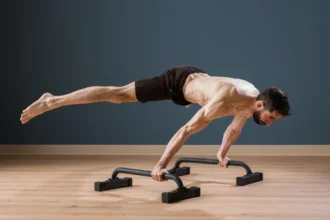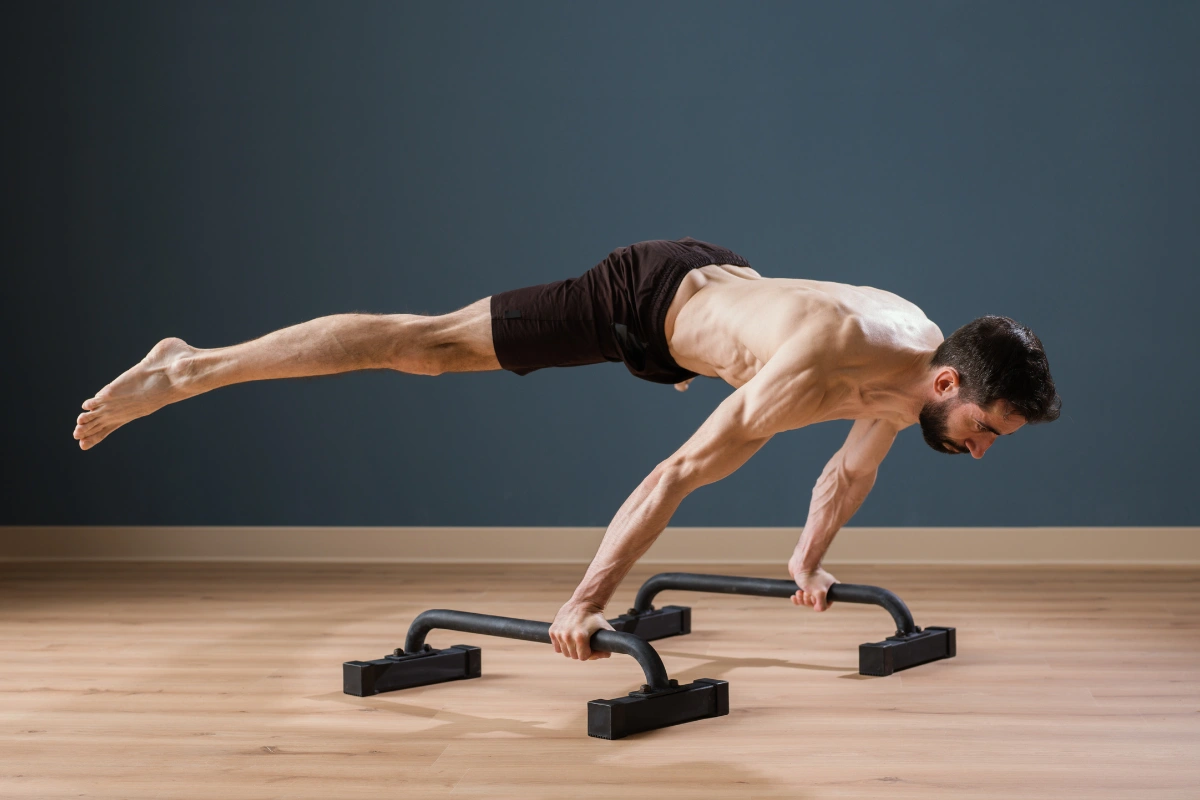When it comes to building strength, flexibility, and endurance, two popular bodyweight training methods stand out: gymnastics and calisthenics. Both use your body weight as resistance, but they differ in their approach, goals, and the skills they develop. Let’s break down these differences in a simple, conversational way.
What Is Gymnastics?
Gymnastics is more than just a sport—it’s a full-body art form. In gymnastics, athletes use their strength, balance, flexibility, and coordination to perform routines on equipment like the floor, balance beam, pommel horse, rings, vault, and parallel bars.
It’s known for its demanding and precise skills, where even small mistakes can affect an entire routine. If you enjoy mastering complex movements and pushing your body’s limits with structured training, gymnastics might be for you.
What Is Calisthenics?
Calisthenics focuses on building strength and endurance through simple, yet effective, bodyweight exercises. Think push-ups, pull-ups, squats, dips, planks, and leg raises.
One of its biggest advantages is that you can do it almost anywhere—no fancy equipment needed. If you love the idea of a flexible workout that strengthens your body for everyday activities, calisthenics might be the right fit.
1. Strength: Who Wins the Power Battle?
Gymnastics
Gymnasts develop strength through complex routines that engage almost every muscle group at once. Whether they’re doing handstands, vaults, or intricate bar routines, they build raw power and control. For example, holding a position like an iron cross on the rings forces every muscle to work together.
Key points:
- Full-body engagement: Every muscle plays a part during a routine.
- Explosive power: Skills like tumbling require quick, powerful movements.
Calisthenics
Calisthenics builds strength with basic moves like push-ups and pull-ups that can be done anywhere. As you progress, you can challenge yourself with advanced variations like muscle-ups or one-arm push-ups.
Key points:
- Adaptable workouts: You can scale exercises up or down based on your level.
- Minimal equipment: Most exercises require just your body—and sometimes a pull-up bar.
Bottom Line: Gymnastics pushes you to develop incredible strength through complex, controlled routines, while calisthenics offers versatile and accessible strength training.
2. Flexibility: Which Routine Helps You Stretch Further?
Gymnastics
Flexibility is a core part of gymnastics. Athletes work hard to gain the range of motion needed to perform splits, backbends, and high kicks. This not only helps in executing tricky routines but also in preventing injuries.
Key points:
- Extreme range of motion: Gymnasts often need to go beyond just touching their toes.
- Dynamic stretching: Regular, varied stretching is part of every training session.
Calisthenics
While flexibility is important in calisthenics too—think deep squats or overhead movements—it isn’t the primary focus. The emphasis is more on functional movements that support your strength and mobility in daily activities.
Key points:
- Functional flexibility: Helps you move better every day.
- Improved joint mobility: Exercises naturally promote better movement in your hips, knees, and ankles.
Bottom Line: Gymnastics requires a higher level of flexibility to perform its advanced moves, whereas calisthenics emphasizes flexibility that supports overall functional strength.
3. Endurance: Which System Pushes You Further?
Gymnastics
Gymnasts need both short bursts of power (anaerobic) and longer periods of stamina (aerobic) to perform routines that can last up to a minute. The combination of explosive moves and sustained holds means gymnasts develop impressive overall endurance.
Key points:
- Strength endurance: Holding challenging positions builds muscle stamina.
- Cardiovascular push: Fast-paced routines boost your heart health.
Calisthenics
Calisthenics often involves doing many repetitions or circuits of exercises. This builds muscular endurance—allowing you to perform more reps and maintain effort over time.
Key points:
- High-repetition sets: Increase muscle endurance gradually.
- Customizable workouts: You can tailor your routine to focus on endurance if that’s your goal.
Bottom Line: Calisthenics typically emphasizes muscular endurance through repeated movements, while gymnastics builds both aerobic and anaerobic endurance through varied and intense routines.
4. Skill Development: Which One Is More Challenging?
Gymnastics
Gymnastics is highly technical. Each move—from a basic cartwheel to a complicated vault—requires years of practice to master. The precision needed for routines on different apparatuses makes gymnastics one of the most skill-intensive sports.
Key points:
- Technical mastery: Skills are honed over time with focused practice.
- Precision and fluidity: Movements must be smooth and controlled.
Calisthenics
Calisthenics also involves skill, especially as you move into more advanced exercises like the human flag or handstand push-ups. However, it generally starts with more straightforward movements that are easy to scale as you improve.
Key points:
- Functional skills: Builds practical strength and control.
- Easily scalable: You can advance at your own pace, starting from basic moves.
Bottom Line: Gymnastics requires a deeper dive into technical skill and precision, while calisthenics focuses on gradual progression in functional strength and control.
5. Injury Risk: Which Is Safer for Long-Term Health?
Gymnastics
Because gymnastics involves high-intensity and complex movements, there is a higher risk of injury—especially during flips, vaults, or dismounts. The stress on joints and ligaments can lead to sprains, strains, or even fractures if not done carefully.
Key points:
- High impact: Complex moves increase the risk of acute injuries.
- Joint stress: Repetitive, high-demand routines can wear down the body over time.
Calisthenics
Calisthenics generally carries a lower risk of injury since many exercises are lower impact and can be modified to suit your level. However, poor form or overtraining can still lead to injuries, especially in the wrists, elbows, and shoulders.
Key points:
- Lower impact: Movements are gentler on the joints.
- Adaptable training: Start slow and progress gradually to reduce injury risk.
Bottom Line: Calisthenics tends to be safer overall, particularly for beginners or those wanting long-term, sustainable fitness, while gymnastics carries a higher risk because of its high-intensity nature.
6. Accessibility and Convenience: Which One Fits Your Lifestyle?
Gymnastics
Training in gymnastics usually requires access to specialized equipment and facilities, which might mean joining a class or traveling to a gym. This can make it less accessible and more expensive for some people.
Key points:
- Requires equipment and supervision: Not as easy to start at home.
- Higher costs: Classes and facilities can be pricey.
Calisthenics
One of the biggest benefits of calisthenics is its simplicity and accessibility. You can perform bodyweight exercises anywhere—at home, in a park, or in your backyard—often with little to no equipment.
Key points:
- Minimal equipment: Just your body (and perhaps a pull-up bar) is enough.
- Flexible and cost-effective: Easy to fit into any schedule without expensive memberships.
Bottom Line: Calisthenics wins on accessibility and convenience, making it a great option for anyone regardless of budget or location.
Which Full-Body Workout Is Right for You?
Both gymnastics and calisthenics offer fantastic benefits for strength, flexibility, endurance, and overall fitness. The best choice for you depends on your personal goals and lifestyle:
- Choose gymnastics if you’re excited by the challenge of mastering complex, technical skills and you have access to the proper facilities. It’s perfect if you love pushing your body to its extreme limits with a structured approach.
- Choose calisthenics if you want a flexible, accessible workout that builds functional strength and endurance without needing specialized equipment. It’s ideal for those who appreciate the freedom to exercise anywhere at their own pace.
No matter which path you choose, both gymnastics and calisthenics can help you achieve a stronger, more agile, and healthier body. Enjoy your training journey!





